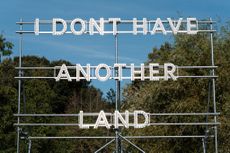Steel yourself for metal guru Antony Gormley’s Royal Academy blockbuster
The British sculptor takes you through a room brambled with steel spindles, inside pitch-black tunnels, before platooning you in a room filled with seawater

Antony Gormley’s blink-and-you’ll miss it Iron Baby (1999) greets the hoards of culture vultures already circling London’s Royal Academy of Arts, ahead of his anticipated self-titled exhibition. Its foetal form, cowering on the Annenberg Courtyard floor, snatches your breath as you enter the RA. ‘I just want to go and cover him up with a blanket,’ says someone. ‘It's going to be a trip hazard,’ jokes another. And so the tone is set for Gormley’s 17-room exhibition, that will literally and figuratively have you on the wrong foot.
Try to find a quiet time to experience it if you can. It’s how the artist – a student of Buddhist meditation – would no doubt want you to experience it. But, despite the crowds, a calming aura settles on each installation. It’s in part down to the Enlightenment-era galleries themselves, which are equal parts imposing and meditative. Gormley was intimately involved in all aspects of the three-year long curation process (as is common with solo exhibitions at the artist-run institution) and he puts the existing architecture to great use.
Indeed, work has been undertaken to reinforce the historic galleries’ floors and walls in anticipation of Gormley’s large-scale sculptures and installations. The Main Galleries have become an armature for sculptural experiment. The veining on the ornate marble-arched doors echoes the rust marks on Gormley’s statues in Lost Horizon I, that sprout from the walls, floor and ceiling, forming a metal forest of faceless men. Elsewhere, in the RA's grandest gallery, miles upon miles of meshwork in Matrix III (2019) builds ever denser, like a cloud formation before a storm, underneath a vast glass skylight.

Matrix III, 2019, by Antony Gormley.
Few new works are present in the exhibition, but all feel fresh in their site-specificity, even for those who are familiar with them. Each is mesmeric in its intense physicality, playing with spatial awareness and perception – a testament to Gormley’s curatorial sensitivity. He has compared the challenges of any particular site to the resistance of marble for the sculptor who carves. No piece exhibits this more than the penultimate one, a giant steel tomb that you can physically enter, seeking pockets of light that reveal themselves as you crawl. Groping your way through the womb-like dark, you come out the other side, and – passing a room flooded with seawater – eventually, into the blinking light of the courtyard. Here, you’re reunited with the Iron Baby you saw on the way in, and brim with a new kind of kinship with it.
It’s easy to be bedazzled, and somewhat distracted, by the large format sculpture on display, but the drawings and small paintings are not to be skimmed over. Handpicked by the artist, they present some of his quieter moments, directly from his 45-year archive. They dart between philosophical musings on quantum mechanics that resemble an architect’s blueprints. Like pages ripped from a diary, they offer intimate insight into Gormley’s thinking – on urbanism, on the body, on our relationship with nature.
With such edifying themes being covered, Gormley was keen to keep a close eye on the commercial arm of the exhibition. And although you exit through the gift shop, a reading room has been planted in-between, with the intention of offering visitors pause for thought after what is a dizzying display. Gormley has edited the shop's product collection, including a stationary collaboration with Muji (Gormley uses its notebooks daily), a cycling jacket with London brand Rapha (the artist is a keen cyclist), and a limited-edition fragrance by famed nose Azzi Glasser.

HOST, 2019, by Antony Gormley.

Body and Fruit, 1991/93, by Antony Gormley.

View of ‘Antony Gormley’ at the Royal Academy of Arts, London.

Slabworks series, 2019, by Antony Gormley. © The artist.

Double Moment, 1987, by Antony Gormley, black pigment, linseed oil and charcoal on paper. © The artist

Earth, Body, Light, 1989, by Antony Gormley, earth, rabbit skin glue and black pigment on paper. © The artist

Lost Horizon I, 2008, by Antony Gormley.
INFORMATION
‘Antony Gormley’, 21 September – 3 December, Royal Academy of Arts. royalacademy.org.uk
ADDRESS
Royal Academy of Arts
Burlington House
London W1J 0BD
Wallpaper* Newsletter
Receive our daily digest of inspiration, escapism and design stories from around the world direct to your inbox.
Elly Parsons is the Digital Editor of Wallpaper*, where she oversees Wallpaper.com and its social platforms. She has been with the brand since 2015 in various roles, spending time as digital writer – specialising in art, technology and contemporary culture – and as deputy digital editor. She was shortlisted for a PPA Award in 2017, has written extensively for many publications, and has contributed to three books. She is a guest lecturer in digital journalism at Goldsmiths University, London, where she also holds a masters degree in creative writing. Now, her main areas of expertise include content strategy, audience engagement, and social media.
-
 RIBA House of the Year 2024: browse the shortlist and pick your favourite
RIBA House of the Year 2024: browse the shortlist and pick your favouriteThe RIBA House of the Year 2024 shortlist is out, celebrating homes across the UK: it's time to place your bets. Which will win the top gong?
By Ellie Stathaki Published
-
 The Nothing Phone (2a) Plus Community Edition taps into the brand's creative followers
The Nothing Phone (2a) Plus Community Edition taps into the brand's creative followersThe unconventional features of Nothing Phone (2a)’s new limited edition come from a community-driven project to reshape the style and ethos of the smartphone
By Jonathan Bell Published
-
 What is the sound of Stone Island? A new musical project helps you find out
What is the sound of Stone Island? A new musical project helps you find outStone Island Sound is a new, evolving music project from the Italian label, seeing contributions from John Glacier, Yaeji and more across playlists and live performances
By Jack Moss Published
-
 Doc'n Roll Film Festival makes its loud return to the UK
Doc'n Roll Film Festival makes its loud return to the UKThe 11th edition of the Doc'n Roll Film Festival celebrates music, culture and cinema from around the world
By Smilian Cibic Published
-
 Preview the Jameel Prize exhibition, coming to London's V&A, with a focus on moving image and digital media
Preview the Jameel Prize exhibition, coming to London's V&A, with a focus on moving image and digital mediaThe winner of the V&A and Art Jameel’s seventh international award for contemporary art and design inspired by Islamic tradition will be showcased alongside shortlisted artists
By Smilian Cibic Published
-
 Genesis Belanger is seduced by the real and the fake in London
Genesis Belanger is seduced by the real and the fake in LondonSculptor Genesis Belanger’s solo show, ‘In the Right Conditions We Are Indistinguishable’, is open at Pace, London
By Emily Steer Published
-
 Francis Bacon at the National Portrait Gallery is an emotional tour de force
Francis Bacon at the National Portrait Gallery is an emotional tour de force‘Francis Bacon: Human Presence’ at the National Portrait Gallery in London puts the spotlight on Bacon's portraiture
By Hannah Silver Published
-
 Frieze Sculpture takes over Regent’s Park
Frieze Sculpture takes over Regent’s ParkTwenty-two international artists turn the English gardens into a dream-like landscape and remind us of our inextricable connection to the natural world
By Smilian Cibic Published
-
 Meet Oluwole Omofemi and Bayo Akande, the founders creating a new art community
Meet Oluwole Omofemi and Bayo Akande, the founders creating a new art communityOluwole Omofemi and Bayo Akande, are behind Piece Unique, an artist agency that guides and future-proofs emerging artists’ careers
By Mazzi Odu Published
-
 Don’t miss these artists at 1-54 Contemporary African Art Fair 2024
Don’t miss these artists at 1-54 Contemporary African Art Fair 2024As the 1-54 Contemporary African Art Fair returns to London (10-13 October 2024), here are the artists to see
By Gameli Hamelo Published
-
 Es Devlin’s large-scale choral installation celebrates London’s displaced population
Es Devlin’s large-scale choral installation celebrates London’s displaced populationEs Devlin has partnered with UK for UNHCR on a free and open-to-all exhibition, ‘Congregation’, in London from 3-9 October 2024
By Hannah Silver Published